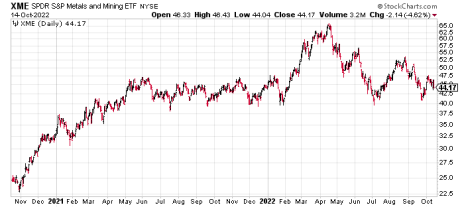Short Interest is Building in the Metals
The experience for base and precious metals investors since March, when most metals peaked, has been something akin to Chinese water torture. To be sure, there have been periodic opportunities in select metals (and related industries) along the way. But the main trajectory for the sector has been steadily lower most of this year.
The last couple of months, however, have held out hope that a bottoming process is underway with the possibility that a new bull market could be just around the corner. But commodity-related markets can be cruel on investors’ nerves, and just when it has seemed that a new rally is about to begin, the market has unceremoniously ripped the rug from under their feet.
The last two weeks have provided another case in point: Just when it looked like precious metals including silver and palladium were on the verge of a turnaround, a sharp reversal ensued which resulted in both markets giving back all their gains from the late-September rally.
Gold, meanwhile, also reversed a breakout attempt earlier this month and has since pulled back to just above its low price for this year of $1,620 an ounce. Even copper has disappointed the bullish expectations of quite a few institutional analysts in stubbornly hovering near its yearly low of $3.25 per pound.
One of the best ways to get a comprehensive view of what metals prices are doing in the aggregate is to look at the SPDR S&P Metals & Mining ETF (XME). The fund tracks a wide variety of metals, including aluminum, copper, diversified metals and mining, gold, silver and steel.
On five separate occasions in the past year and a half, XME has tagged the 40 level, which is a long-term chart “support” level. But in each case, the market showed its resilience in refusing to break under the benchmark level, as you can see here.
However, in the latest pullback in XME during October, the ETF has so far resisted sellers’ attempts at forcing another trip down to 40. If XME can maintain this strength and finally push above 50, a new short-term uptrend will finally be established. More importantly, this would almost certainly result in a drastic improvement in the market’s psychological profile, giving investors the confidence to resume a bullish posture in the leading metals. And a further likely result would be that a big short-interest increase in recent months (XME’s short interest stands at almost 30% of shares outstanding!) could serve as the fuel for the first sustained rally in the metals market we’ve seen since earlier this year.
What could serve as the catalyst for a big short-covering rally in the metals? A couple of potential events come to mind as the most likely triggers. One such event would be a strong reversal of the interest rate uptrend, as long-term government bond yields have been on a rip-and-tear since March (around the time when the metals peaked).
Another potential catalyst would be a drop in the U.S. dollar index, which has been in the ascent for most of this year and has clearly exerted a negative influence on prices (due to the inverse correlation between the currency and the metals).
As discussed in the previous issue, the global trend toward “de-dollarization” will go a long way toward eventually eroding confidence in the dollar and, presumably, increasing safety-related demand for gold as the greenback loses its status as the world’s preferred haven.
For now, though, it’s important that we continue to focus on the prevailing trends, which are down for most metals and up for the dollar. At the same time, we must be prepared for the critical point—which may indeed be close at hand in view of the aforementioned short interest buildup—when the metals signal the time has arrived for a trend reversal.
Updates
As a temporary holding until the gold price outlook improves, investors may wish to own a conservative position in the Invesco DB U.S. Dollar Index Bullish Fund (UUP). I previously suggested using a level slightly under 29 as the stop-loss for this position; I now recommend raising the stop to slightly under 29.50. BUY A HALF
Kinross Gold (KGC) is a senior mining firm that acquires, explores and develops gold properties in the U.S., Canada, Brazil, Chile, and Mauritania. Kinross was one of the few actively traded gold miners that posted higher revenue from a year ago in Q2, with total sales of $822 million increasing 16% from the comparable 2021 quarter. The company also reported cash and equivalents of $719 million and total liquidity of approximately $2 billion as of the quarter’s end—plenty of capital to take on new projects and fund existing operations. Management also provided upbeat guidance, with plans to “significantly” increase production in the second half of the year, primarily driven by stronger production at its Paracatu, Tasiast and La Coipa gold projects. Kinross expects all-in sustaining costs per gold equivalent ounce sold to be approximately $1,240—about $430 per ounce above the current gold price. On the development front, the company is proceeding with development of its 70%-owned Manh Choh project in Alaska, which is expected to increase the firm’s production profile by approximately 640,000 attributable ounces over the life of mine at lower costs. Kinross’s world-class Great Bear project in Ontario, meanwhile, continues to make excellent progress, with drilling results from the first half of the year continuing to confirm Kinross’ vision of developing a large, long-life mining complex. Most recently, Kinross announced approval from the Toronto Stock Exchange to increase normal course issuer bid as part of the firm’s $300 million stock buyback program. The amendment increases the maximum number of common shares that may be repurchased (up to 65 million shares), representing 10% of the company’s public float. Purchases under the bid began August 3 and will end no later than next August 3. The stock is showing observable relative strength versus most actively traded gold shares, suggesting accumulation by informed interests is taking place. Participants can accordingly purchase a conservative position in KGC using a level slightly under 3.30 as the initial stop-loss on a closing basis. The next earnings report is due out November 9. BUY A HALF
As previously discussed, white metals—particularly palladium—are holding their own relative to other metals. And while I’m not yet ready to pull the trigger on our favorite platinum/palladium ETF, I’m keeping a close watch on one of the biggest stocks in this segment, Platinum Group Metals (PLG). The South African-based company is focused on platinum and palladium production and operates the Waterberg large-scale platinum group metal (PGM) resource, which has an attractive risk profile given its shallow nature. The project also has the potential to be one of the lowest-cost operations in the PGM sector. An even bigger attraction for the company right now, however, is its partnership with Anglo American Platinum (ANGPY). The two companies have created Lion Battery Technologies to support the use of palladium and platinum in lithium battery applications. Lion has entered into an agreement with Florida International University to further advance a research program that uses platinum and palladium to unlock the potential of Lithium Oxygen and Lithium Sulfur battery chemistry, which can perform better, by orders of magnitude, than the best-in-class Lithium-ion batteries currently on the market. This new generation of lightweight, powerful batteries has the potential to grow to scale on the back of the attractiveness of electric vehicles (EVs) and the use of lithium batteries in other applications beyond mobility. Given that alternative energy is one of the market’s strongest performing sectors right now, this could position PLG to significantly outperform in the coming quarters. Accordingly, I’m recommending that we purchase a conservative position in PLG if the stock closes above 1.80 (the stock most recently closed at 1.50). BUY A HALF ABOVE 1.80.
| Stock | Price Bought | Date Bought | Price on Oct. 17 | Profit | Rating |
| Invesco U.S. Dollar Bullish ETF (UUP) | 30.3 | 9/26/22 | 30.5 | 1% | Buy a Half |
| Kinross Gold (KGC) | 3.75 | 10/4/22 | 3.4 | -9% | Buy a Half |
Buy means purchase a position at or around current prices.
Buy a Quarter/Half means allocate less of your portfolio to a position than you normally would (due to risk factors).
Hold means maintain existing position; don’t add to it by buying more, but don’t sell.
Sell means to liquidate the entire (or remaining) position.
Sell a Quarter/Half means take partial profits, either 25% or 50%.

